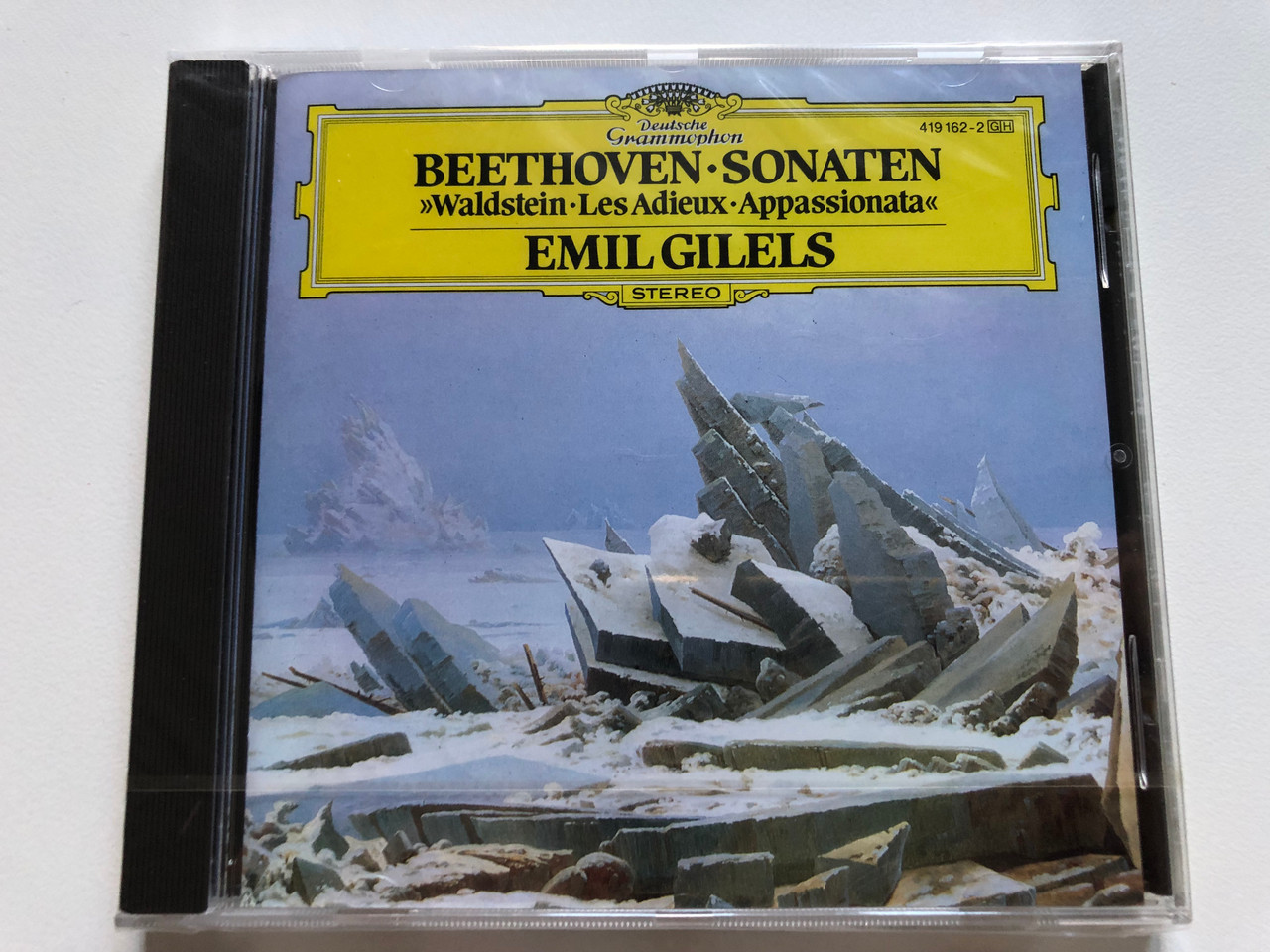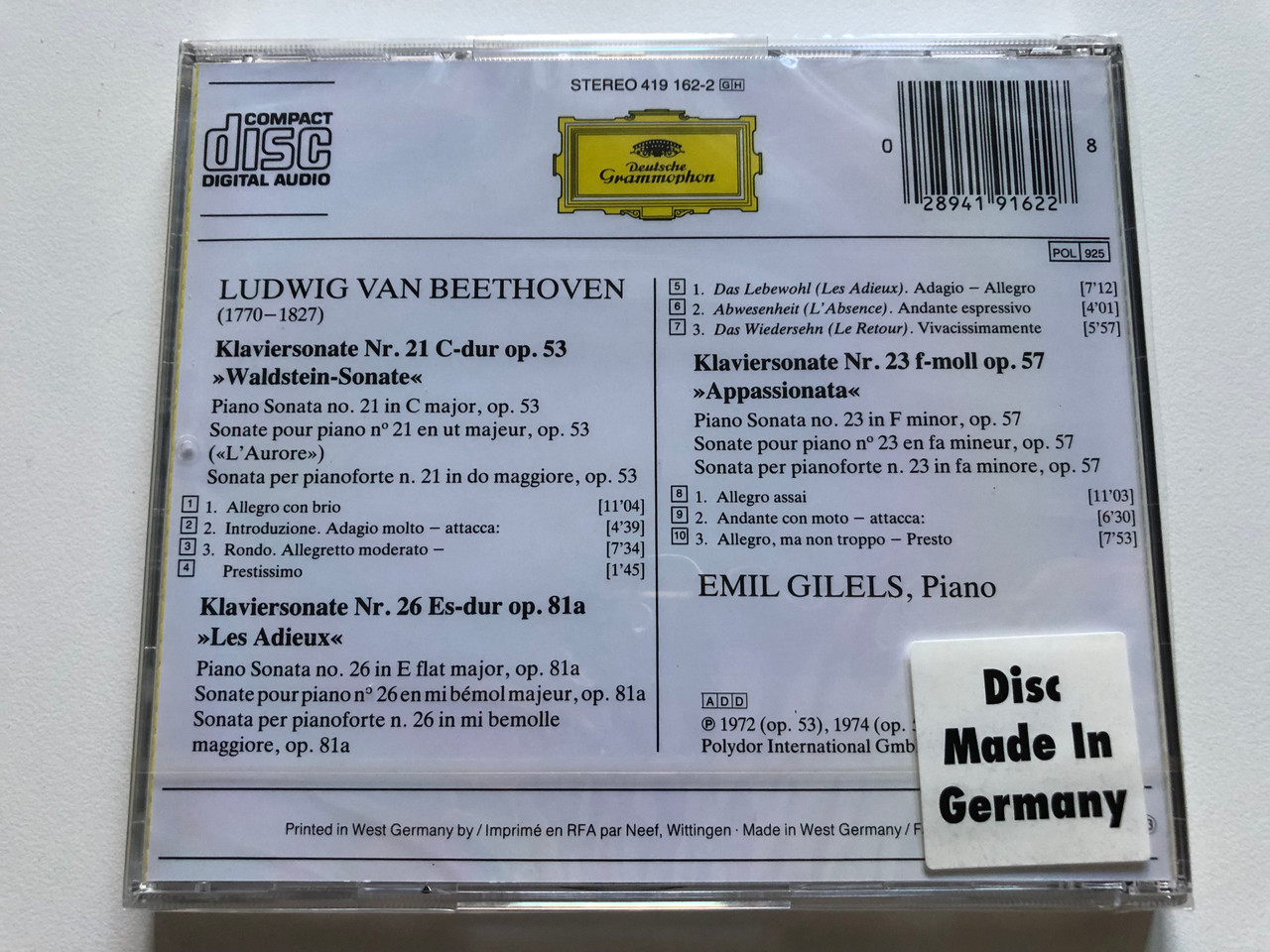Description
Beethoven - Sonaten »Waldstein·Les Adieux·Appassionata« - Emil Gilels / Deutsche Grammophon Audio CD Stereo / 419 162-2 GH
UPC 028941916228
Beethoven's Piano Sonata No. 21 in C major, Op. 53, known as the Waldstein, is one of the three most notable sonatas of his middle period (the other two being the Appassionata, Op. 57, and Les Adieux, Op. 81a). Completed in summer 1804 and surpassing Beethoven's previous piano sonatas in its scope, the Waldstein is a key early work of Beethoven's "Heroic" decade (1803–1812) and set a standard for piano composition in the grand manner.
The sonata's name derives from Beethoven's dedication to his close friend and patron Count Ferdinand Ernst Gabriel von Waldstein, member of Bohemian noble Waldstein family (Valdštejn). Like the Archduke Trio (one of many pieces dedicated to Archduke Rudolph), it is named for Waldstein even though other works are dedicated to him. It is also known as L'Aurora (The Dawn) in Italian, for the sonority of the opening chords of the third movement, thought to conjure an image of daybreak.
It is considered one of Beethoven's greatest and most technically challenging piano sonatas. The first section of the rondo requires a simultaneous pedal trill, high melody and rapid left hand runs, and the coda features glissando octaves written in dialogue between the hands.
An average performance of the entire Waldstein lasts about twenty-five minutes.
Ludwig van Beethoven's Piano Sonata No. 26 in E♭ major, Op. 81a, known as Les Adieux ("The Farewell"), was written during the years 1809 and 1810.
The title Les Adieux implies a programmatic nature. The French attack on Vienna, led by Napoléon Bonaparte in 1809, forced Beethoven's patron, Archduke Rudolph, to leave the city. Yet, there is some uncertainty about this nature of the piece — or at least, about the degree to which Beethoven wished this programmatic nature should be known. He titled the three movements "Lebewohl", "Abwesenheit", and "Wiedersehen" ('farewell', 'absence', and 'reunion'), and reportedly regarded the French "Adieux" (said to whole assemblies or cities) as a poor translation of the feeling of the German "Lebewohl" (said heartfully to a single person). Indeed, Beethoven wrote the syllables "Le-be-wohl" over the first three chords.
On the first 1811 publication, a dedication was added reading "On the departure of his Imperial Highness, for the Archduke Rudolph in admiration".
An average performance of the piece lasts about 17 minutes. The sonata is one of Beethoven's most challenging sonatas because of the mature emotions that must be conveyed throughout as well as the technical difficulties involved. It is also the bridge between his middle period and his later period and is considered the third great sonata of the middle period.
Ludwig van Beethoven's Piano Sonata No. 23 in F minor, Op. 57 (colloquially known as the Appassionata, meaning "passionate" in Italian) is among the three famous piano sonatas of his middle period (the others being the Waldstein, Op. 53 and Les Adieux, Op. 81a); it was composed during 1804 and 1805, and perhaps 1806, and was dedicated to Count Franz von Brunswick. The first edition was published in February 1807 in Vienna.
Unlike the early Sonata No. 8, Pathétique, the Appassionata was not named during the composer's lifetime, but was so labelled in 1838 by the publisher of a four-hand arrangement of the work. Instead, Beethoven's autograph manuscript of the sonata has "La Passionata" written on the cover, in Beethoven's hand.
One of his greatest and most technically challenging piano sonatas, the Appassionata was considered by Beethoven to be his most tempestuous piano sonata until the twenty-ninth piano sonata (known as the Hammerklavier). 1803 was the year Beethoven came to grips with the irreversibility of his progressively deteriorating hearing.
An average performance of the entire Appassionata sonata lasts about twenty-five minutes.
| Label: | Deutsche Grammophon – 419 162-2 GH |
|---|---|
| Format: |
CD, Compilation, Stereo
|
| Country: | Europe |
| Released: |
|
| Genre: | Classical |
| Style: | Classical, Romantic |
Tracklist:
| Klaviersonate Nr.21 C Dur Op. 53 »Waldstein Sonate« | |||
| 1 | 1. Allegro Con Brio | 11:04 | |
| 2 | 2. Introduzione. Adagio Molto - Attacca: | 4:39 | |
| 3 | 3. Rondo. Allegretto Moderato - | 7:34 | |
| 4 | Prestissimo | 1:45 | |
|
Klaviersonate Nr.26 Es-Dur Op. 81a »Les Adieux« |
|||
| 5 | 1. Das lebewohl (Les Adieux). Adagio - Allegro | 7:12 | |
| 6 | 2. Abwesenheit (L'Absence). Andante Espressivo | 4:01 | |
| 7 | 3. Das Wiedersehen (Le Retour). Vivacissimamente | 5:57 | |
|
Klaviersonate Nr.23 F-Moll Op. 57 »Appassionata« |
|||
| 9 | 1. Allegro Assai | 11:03 | |
| 10 | 2. Andante Con Moto - Attacca: | 6:30 | |
| 11 | 3. Allegro, Ma Non Troppo - Presto | 7:53 |
- Art Direction – Lutz Bode
- Composed By – Ludwig van Beethoven
- Engineer – Hans-Peter Schweigmann, Klaus Scheibe
- Illustration, Cover – C. D. Friedrich
- Liner Notes – Denis Matthews, Hartmut Fladt
- Liner Notes [French Translation] – Carole Boudreault
- Liner Notes [Italian Translation] – Adriano Cremonese
- Photography By – Henry Grossman
- Piano – Emil Gilels
- Recording Supervisor, Production Manager – Günther Breest


























